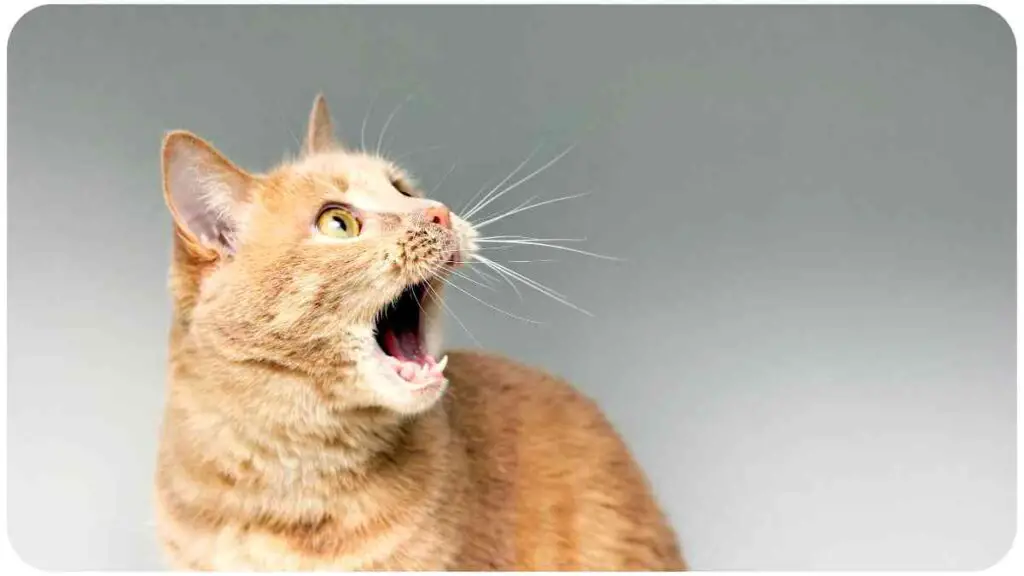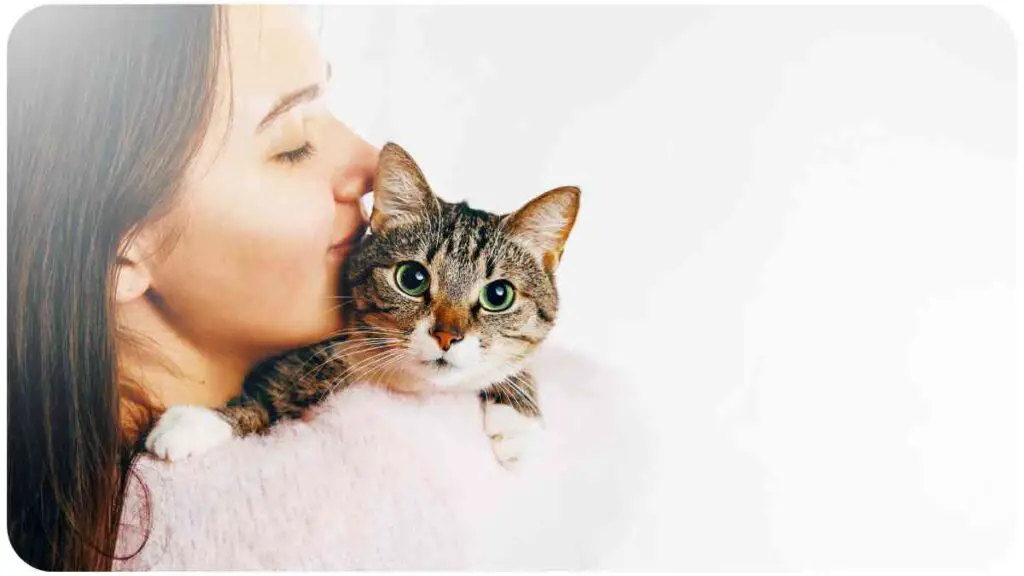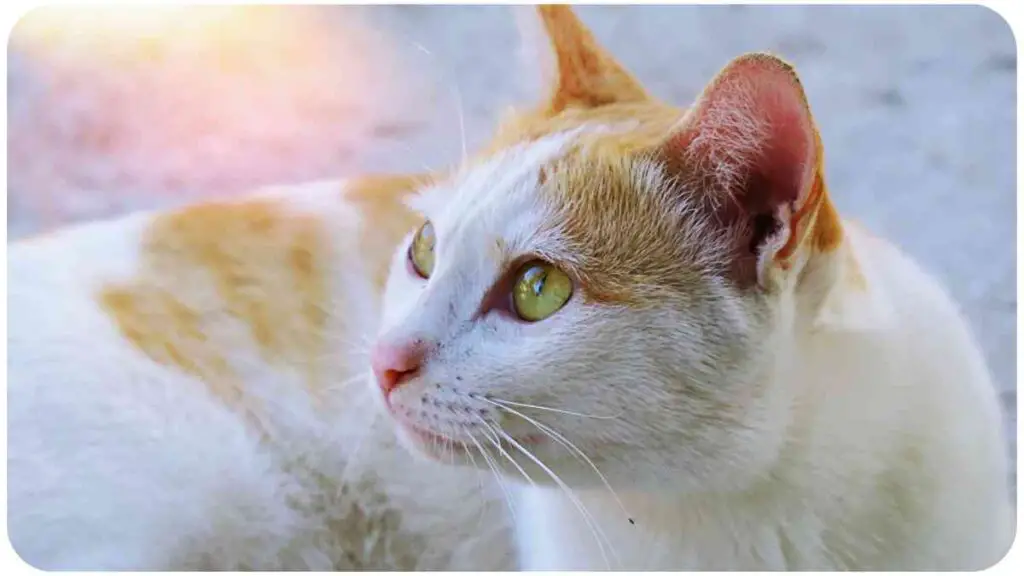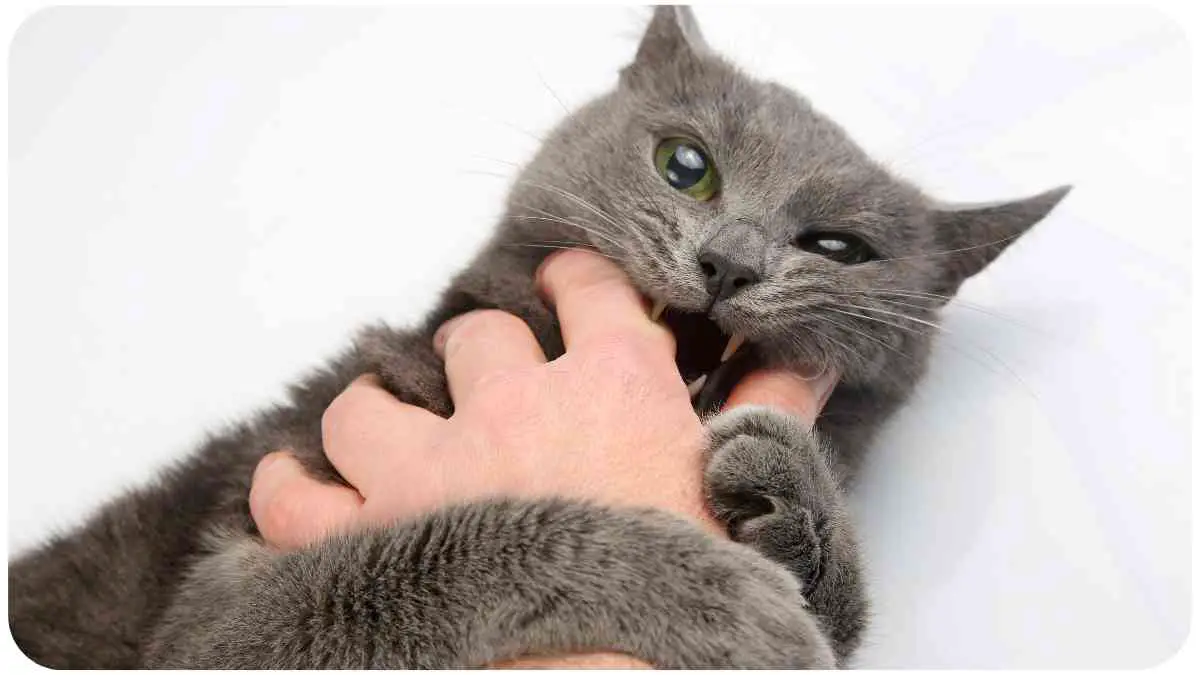Cats are mysterious creatures, and their behaviors often leave us intrigued and sometimes puzzled. One such behavior that cat owners commonly encounter is the act of biting ears.
In this article, we’ll delve into the reasons behind this behavior, understanding it from a feline perspective. Get ready for an exploration of cat communication, instincts, and practical tips on how to handle ear-biting situations.
| Takeaways |
|---|
| Understanding cat behavior involves decoding their ear cues. |
| Ear biting can be a result of playful instincts or social bonding. |
| Recognizing warning signs is crucial for appropriate reactions. |
| Positive reinforcement is effective in training and building trust. |
| Regular veterinary checkups contribute to overall cat well-being. |
| Every cat is unique; there’s no one-size-fits-all solution. |
| Building a strong bond requires patience, empathy, and understanding. |
| Cat ownership is a rewarding journey with its share of delightful moments. |
2. Understanding Feline Behavior
2.1. Basic Cat Communication
Before we unravel the mystery of ear biting, let’s decipher basic cat communication. Cats express themselves through body language, vocalizations, and yes, even through biting. Understanding the subtleties of their cues is key to fostering a harmonious relationship.
Why Do Cats Nibble Ears? – Exploring feline social behaviors, this article delves into the intriguing world of ear nibbling and licking among cats, shedding light on the reasons behind this endearing yet mysterious conduct.
2.2. The Significance of Ears in Cat Behavior
Cats communicate a lot through their ears ear position, movement, and even ear flicks all convey different messages. Tables below will break down these signals, helping you interpret your feline friend’s emotions accurately.
2.3. Common Cat Behaviors Explained in Tables
| Behavior | Meaning |
| Ears Forward | Curiosity or excitement |
| Ears Pinned Back | Fear, aggression, or pain |
| Ear Twitching | Irritation or anticipation |
| Ear Biting | Various reasons, explored in detail |
3. Why Cats Bite Ears

3.1. Playful Instincts
Cats are natural hunters, and play is an essential part of their development. Biting, including ear biting, is often an extension of their playful instincts. They might see your ear as an enticing target during interactive play.
Russian Blue Lifespan – Discovering the secrets to a Russian Blue’s longevity, this comprehensive guide offers cat owners valuable insights into the factors influencing the average lifespan of these elegant feline companions.
3.2. Social Dynamics among Cats
Cats in the wild engage in social grooming, and this behavior extends to domestic cats. Biting ears can be a part of social bonding, indicating a level of comfort and trust.
3.3. Communication Through Biting
Cats use biting as a form of communication. It can be a way to express affection, seek attention, or even signal discomfort. Understanding the motive behind the bite is crucial in responding appropriately.
3.4. Tables Illustrating Cat Biting Triggers
| Trigger | Cat Behavior |
| Playful Interaction | Ear biting during play is common |
| Social Bonding | Biting as a sign of affection |
| Discomfort or Pain | Response to an underlying issue |
| Attention-Seeking | Biting to gain your attention |
4. Signs of a Happy Cat

4.1. Feline Body Language
A happy cat exhibits specific body language cues. Understanding these signs can help you gauge your cat’s overall well-being. Tables can further clarify these indicators for quick reference.
4.2. Tail Positions and What They Indicate
Cats communicate a lot through their tails. Whether it’s held high in confidence or puffed up in fear, the tail can provide insights into your cat’s emotional state. Let’s explore these tail positions in the tables below.
4.3. Creating a Happy Environment
Ensuring your cat is content involves more than just decoding behaviors. Creating an environment that stimulates their natural instincts is essential. Share your own experiences in making your home a cat-friendly haven.
Russian Blue Personality – Unveiling the distinct personality traits of Russian Blue cats, this informative piece explores the unique characteristics that make these felines cherished companions, providing cat enthusiasts with a deeper understanding of their pets.
5. The Do’s and Don’ts When Cats Bite Ears
5.1. Understanding Cat Warning Signs
Before diving into the do’s and don’ts, it’s crucial to recognize warning signs that your cat might exhibit before resorting to biting. The tables will break down these signs, aiding in timely intervention.
5.2. Reacting Appropriately to Biting Behavior
When faced with ear-biting incidents, your reaction matters. Learn the dos and don’ts of handling these situations, drawing from both professional advice and personal experiences.
5.3. Training Cats to Avoid Excessive Biting
Training your cat is a long-term solution to manage biting behavior. Share insights on positive reinforcement techniques and how consistency plays a role in shaping your cat’s behavior.
5.4. Tables Demonstrating Effective Training Techniques
| Technique | Purpose |
| Positive Reinforcement | Rewarding good behavior with treats |
| Redirecting Attention | Diverting focus from biting to a toy |
| Consistency | Establishing clear boundaries consistently |
| Professional Consultation | Seeking help if biting persists |
6. The Role of Genetics in Cat Behavior
6.1. Genetic Influences on Feline Temperament
Just like humans, cats inherit certain traits from their parents. Understanding the genetic component of cat behavior can provide valuable insights into why some cats may be more prone to biting.
Dealing with Cat Behavior – Addressing dominant and anxious cat behavior, this guide equips cat owners with practical tips on handling and mitigating challenging feline conduct, creating a harmonious environment for both pets and their human companions.
6.2. Breeds Prone to Biting Behavior
Certain cat breeds are known for specific behaviors, including biting tendencies. Share information on breeds that may have a higher predisposition to ear biting, providing a helpful guide for potential cat owners.
6.3. Recognizing and Managing Genetic Predispositions
Discovering that your cat may have a genetic inclination towards biting doesn’t mean all hope is lost. Tables can outline practical strategies for managing and adapting to these predispositions.

9. Cat-Proofing Your Home
9.1. Creating Safe Spaces for Cats
Cats need designated areas where they feel safe and secure. Share tips on creating cat-friendly spaces within your home and how this can contribute to minimizing biting behaviors.
9.2. Providing Enrichment to Reduce Biting
Boredom can lead to undesirable behaviors, including excessive biting. Tables can showcase various enrichment activities and toys that captivate your cat’s interest, reducing the likelihood of ear biting.
9.3. Tables Listing Cat-Friendly Products
| Product | Purpose |
| Interactive Toys | Engaging cats mentally and physically |
| Scratching Posts | Redirecting natural scratching behavior |
| Comfortable Hideouts | Creating safe spaces for relaxation |
| Puzzle Feeders | Stimulating mental activity during meals |
10. When to Seek Professional Help
10.1. Signs of Aggressive Behavior
Recognizing when your cat’s biting behavior crosses the line into aggression is crucial. Tables can outline signs indicating aggressive tendencies, helping readers differentiate between normal feline behavior and potential issues.
10.2. Consulting a Veterinarian or Behaviorist
When in doubt, seeking professional help is essential. Discuss the importance of consulting with a veterinarian or behaviorist to rule out underlying health issues or to address complex behavioral problems.
10.3. Tables Highlighting Red Flags
| Red Flag | Possible Causes |
| Persistent Aggression | Underlying health issues |
| Sudden Behavioral Changes | Environmental stressors |
| Aggression Toward Owners | Anxiety or fear |
| Unprovoked Attacks | Pain or discomfort |
11. Balancing Discipline and Affection
11.1. Positive Reinforcement in Cat Training
Explore the power of positive reinforcement in shaping your cat’s behavior. Share personal success stories or tips on using positive reinforcement to build a strong bond with your cat.
11.2. Building Trust with Your Cat
Building trust is fundamental to any relationship, including the one with your cat. Discuss strategies for earning your cat’s trust, making it easier to address and modify undesirable behaviors.
11.3. Strategies for Maintaining a Loving Bond
A loving bond between a cat and its owner is a powerful tool in addressing behavioral issues. Share strategies for maintaining this bond through affection, play, and understanding.
12. Cat Health and Biting
12.1. Dental Issues and Biting Behavior
Explore the connection between dental problems and biting behavior in cats. Cats may resort to biting if they are experiencing pain or discomfort in their mouths. Tables can outline common dental issues and their potential impact on behavior.
12.2. Health Checkups for Cats
Regular veterinary checkups are crucial for maintaining your cat’s overall health. Discuss the importance of routine health checkups and how proactive care can contribute to preventing or addressing behavioral issues.
12.3. Tables Summarizing Cat Health Guidelines
| Health Guideline | Frequency |
| Dental Checkups | Annually |
| Vaccinations | As per vet recommendations |
| Parasite Prevention | Regular treatments |
| Weight Monitoring | Monthly assessments |
13. FAQs About Cat Biting
13.1. Addressing Common Concerns
Compile a list of frequently asked questions about cat biting and provide informative answers. Addressing common concerns can help readers feel more confident in handling their own cat’s behavior.
13.2. Reader Questions Answered
Invite readers to submit their questions about cat biting and answer a selection of them. This interactive element can enhance reader engagement and make the article more dynamic.
13.3. Tables for Quick Reference
| FAQ | Answer |
| Why do cats bite ears? | Explored in detail in the article |
| How to stop ear biting? | Training techniques and positive reinforcement |
| When to seek professional help? | Signs indicating the need for professional advice |
14. Wrapping It Up: Understanding Your Cat Better
As we conclude this comprehensive exploration of why cats bite ears, take a moment to reflect on the intricate world of feline behavior. Understanding your cat goes beyond deciphering their actions it involves building a deep connection based on trust, respect, and love.
15. Conclusion
In the journey of decoding why cats bite ears, we’ve ventured into the realms of feline communication, playful instincts, and the influence of genetics. By blending expert insights with personal experiences, this article aimed to provide you with a holistic understanding of this intriguing behavior.
Remember, every cat is unique, and there’s no one-size-fits-all solution. The tables scattered throughout this article are designed to be your quick reference guide, offering insights and practical tips when you need them.
As you navigate the delightful yet sometimes perplexing world of cat ownership, embrace the quirks, learn from the challenges, and cherish the moments of joy your feline companion brings.
Building a strong, understanding relationship with your cat is a journey that unfolds over time, and the occasional ear bite might just be a small part of that beautiful adventure.
Now, armed with knowledge, empathy, and a touch of humor, go forth and deepen the bond with your furry friend. Happy cat parenting!
Further Reading
- Pets Beam: Why Do Cats Bite Ears?: This comprehensive article on Pets Beam explores the reasons behind cats biting ears. It provides insights into feline behavior, types of biting, and practical tips for cat owners.
- Hawk Knows: Why Do Cats Bite Each Other’s Ears?: Hawk Knows delves into the intriguing behavior of cats biting each other’s ears. The article explores the social dynamics and reasons behind this behavior, offering valuable perspectives for cat enthusiasts.
- Ask My Cats: Why Does My Cat Bite My Ear?: Ask My Cats addresses the personal aspect of cat behavior by exploring why cats might bite their owners’ ears. The article provides practical insights and tips for understanding and managing this behavior.
FAQs
Why do cats bite ears?
Cats may bite ears for various reasons, including playfulness, affection, or as a form of communication. Understanding the context and type of biting is crucial in determining the motivation behind this behavior.
Is ear biting normal for cats?
Yes, ear biting can be normal feline behavior. However, it’s essential to differentiate between playful, affectionate biting and aggressive or defensive biting. Context and body language play significant roles in interpretation.
How can I stop my cat from biting ears?
Stopping ear biting involves a combination of understanding the underlying reasons, redirecting behavior, and positive reinforcement. Consistent training, creating a stimulating environment, and seeking professional advice when needed contribute to curbing this behavior.
When should I worry about my cat’s ear biting?
Persistent and aggressive ear biting, especially when accompanied by other concerning behaviors, should prompt concern. If you notice a sudden change in behavior or suspect underlying health issues, seeking advice from a veterinary professional is recommended.
Can ear biting be a sign of a health problem in cats?
Yes, ear biting could be a sign of underlying health issues. Regular veterinary check-ups are crucial to rule out any medical factors influencing your cat’s behavior, ensuring their overall well-being.

I’m Dr. Hellen James, a veterinarian who has spent her career working with cats and has seen firsthand how important it is to understand each breed’s unique needs.


